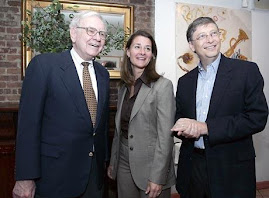In 2004, I have a few reasons why we should avoid Breadtalk. But now, I have even more reasons to invest in this company. I shared with a few colleagues and friends including Mr. Philip Comd (the one who says “by the time their franchise business become successful, the share price would have gone up”) to buy Breadtalk. Its share was quite illiquid then trading around $0.23 a share. But it doesn’t matter to me. Why? Because I am not trading, I am investing! That’s why! And after Breadtalk released its annual report for 2006 in Feb 2007, it just confirmed that my analysis is correct.
I like all my readers to remember this. Sometime Mr. Market overlooked a growth company. Here we have one good example. I am not suggesting that Breadtalk will definitely grow for the next five years, but its growth for the last few years has been impressive. Most importantly, Breadtalk now has attributes that Warren Buffett always look out for – growth, intrinsic value, strong brand, necessity, business that is simple to understand etc. Enough of talking, let’s go into Breadtalk’s financial statements.
I have a spreadsheet with formulated cells for ratio analysis. By punching in figures from a company’s annual reports, ratio computation will be done automatically. I also have my own rating system but it is classified. The followings are my interpretation of Breadtalk’s financial performance:

- Its liquidity is acceptable although it is below the ratio of 2:1. We need to understand that Breadtalk’s business is mostly in cash term and with low inventory. One thing for sure, they can’t and they won’t keep their bread overnight.
- NP margin has improved steadily, though still not impressive enough. If you asked me “how would I be impressed”, personally I would love 15% - 20% sustainable NP margin. Previously it has high GP margin but extremely thin NP margin. This goes to explain that it has high operational expenses such as labour and rental. However, I am sure that the management is aware of these problems and has controlled its bakery outlet expansion locally. Instead, they expanded their bakery outlet outside Singapore, particularly in China.
- Returns on equity (ROE) shows marked improvement indicates that company has deployed resources effectively thus generating shareholder value.
- Though gearing has increased, but by my personal yardstick, Breadtalk’s gearing is still healthy.
- PE was about 12 times in Dec 2006 and considered attractive then. It is about 22 times in Aug 2007.
- Price-to-book (PTB) ratio is definitely above 1 considers that Breadtalk does not need to invest heavily in assets. That’s why it has low NTA. Perfectly sensible to me. But in Aug 2007, the PTB is rather high due to higher share price.
- Dividend sucks. But for a growth company, it is perfectly ok not.jpg) to distribute dividends. By the way, Warren Buffett doesn’t believe in giving out dividends. This is because he knows that if he gives out dividends, shareholders might put it in other lousy investments. In the hands of Warren Buffett, it will be compounded at around 25% a year.
to distribute dividends. By the way, Warren Buffett doesn’t believe in giving out dividends. This is because he knows that if he gives out dividends, shareholders might put it in other lousy investments. In the hands of Warren Buffett, it will be compounded at around 25% a year.
- Breadtalk’s share issue is quite thin. Based on my experience, average small/mid cap companies tend to have around 500 million issued shares. For the year ended 31 Dec 2006, Breadtalk’s issued share is only approximately 200 million. You know what that means? That means when Mr. Market finds out what I discovered, Breadtalk’s share price will surge (and it did in mid-2007).
- The revenue growth from Bakery and food court are impressive. Its franchise business increased tremendously but we are still .jpg) waiting for it to translate into wonderful revenue contribution.
waiting for it to translate into wonderful revenue contribution.
Breadtalk’s fundamental has changed. Besides franchise business, I am also excited on its food court business. In Jul 2007, I saw Breadtalk’s new food court “大食代” (Food Republic) below Suntec Conventional Hall. That food court, oh my god, it is fantastic. It is not just a food court, it’s a classy food court. It’s like back to old times, or as if you are dining in a library. Go visit that outlet but don’t go during weekends or peak hours.
3) Consensus reports
Have you forgotten that I am still touching on how to evaluate a business? This is part 2 of a previous article. Don’t get too carried away with Breadtalk. In fact, I am not suppose to cover financial analysis here. It is suppose to be just qualitative analysis. Anyway, what the hack! Now, there are tonnes of analysts writing their reports everyday but only handful are really, really good. The rest of them…. I better don’t comment else I might get beaten up. If you have friends working in broking/fund houses, go ask them how analysts rush their reports. They are trained no doubt, but take these analysts’ reports with a pinch of salt. In any case, their forecast figures for the next 3 years will change frequently after a company releases its financial report.
So now you realised that I didn’t forecast Breadtalk’s financial statement for next three years. I don’t forecast profit or losses; only God can see the future. I hope you are not disappointed. Notwithstanding all that I said above, there are also good analysts such as Ms Teh Hooi Ling, BT Senior Correspondent which I had introduced to many of my friends. Professional analysts have sources, huge database and connections to get latest information. They are also able to interview top management of a listed company easily. So by collating and studying the analysts’ reports, I can see if it concurs with my findings. If the answer is yes, then it is even highly probable that my analysis is correct. You want living example? Here’s one but you might think that it’s all bullshit. Nonetheless, I’ll still share with you. About two years ago, I was very interested in Ausgroup. I believed that it is a growth company which has been largely overlooked. Its share was rather illiquid until Ms the Hooi Ling issue a report in Business Times. Most of us bought it at around $0.25 - $0.30. Supported with growing profit, its share price skyrocketed to $2 in mid-2007. But we have already locked in our profit.
This article is a bit long; I have to end it here. In conclusion, open your eyes and ears especially when you are in a group or in shopping mall, and take note of things happening around you can help you to make correct investment decision. In this way, it mitigates our shortcomings as a retail investor.



